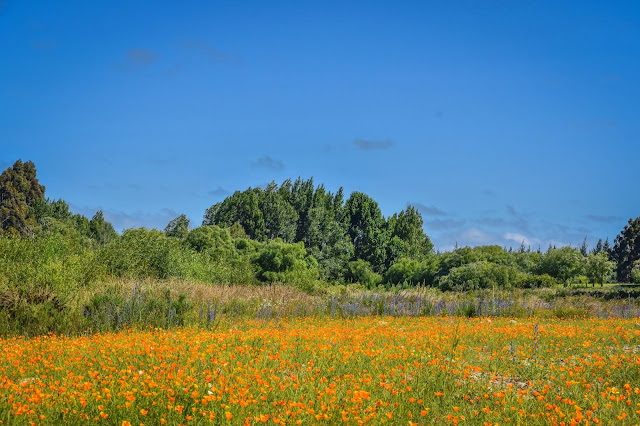Loburn was named after John Macfarlane's sheep station, which was originally named Lowburn. The river flows between steep banks, so the river (or burn) was low.
Between 1914 and 1916 small orchards were planted in the area, which made it one of Canterbury's few fruit growing areas. Nowadays the local industries around Loburn are a cheese factory and orchards. The farms in the area include sheep, cattle and emus.
We stayed overnight behind the Rangiora Leigh Holiday park. The owners of the park, have put aside a special area for NZMCA members to use (for a small cost per person).
It was a stunning day when we arrived. We were the only ones there, although a caravan and bus had been left, while the owners were away.
Not long after arriving, Rob (the owner) came by with his tractor & mower. He whipped around the grass and in no time at all we had a freshly mown patch of lawn to spread out on.
 |
| Before: Lots of clover & lots of busy bees. |
I noticed a sign saying 'River Access' so Oakly and I went for a walk. Boo wanted to stay at the bus with Bernie. And of course Bernie wanted a cuppa!
Although it wasn't deep enough for a swim, it was enough to wet our ankles and cool us down. The wild flowers (a mixture of blue borage, poppies and daisies) growing along the riverbank were beautiful.
I'm always amazed at how some flowers can survive growing in shingle. I picked a bunch of these 'Californian Poppies' to put in the bus. Californian Poppies thrive is poor, stony or sandy soils and love a hot, dry climate. Their orangey-yellow petals open in the sun and close at night.
A few friendly Clydesdale horses were grazing in the paddock beside us. I love these draft horses' gentle natures and the feathering on their ankles, along with their giant hooves - such majestic creatures.
As you may already know, Clydesdale horses are one of the largest horses in the world and were originally derived from the farm horses of Clydesdale (a county in Scotland). They are an active horse with a high stepping action. Their primary role was being used for agriculture and haulage and are still used today for draught purposes. These gentle giants are also used for showing, riding and kept as pets for pleasure.
The most common colours are bay and brown, usually with a white face or 'blaze' and lots of white on the lower legs. One of the Clydesdale's most distinctive features is the silky feathering on the legs.
The Holiday Park was immaculate. The area near us was like a small village of permanent caravan and fifthwheel dwellings. Each was set up with a carport, outdoor decking and manicured gardens. Every property had paving and fences or a hedge partition, making the area look established and very well cared for.
As the sun began to set, Boo spotted a hare bobbing across the paddock and spent the rest of the night, glued to the window, on rabbit-watch. It was a peaceful place to stay - if you're looking for a spot that isn't crowded and one that you can put your feet up and relax, then I'm sure you'll enjoy staying here.














No comments:
Post a Comment
Leave a comment - I'd love to hear from you.